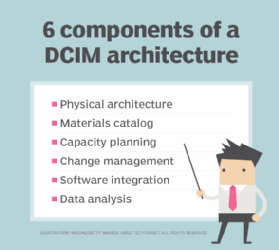What is data center infrastructure management (DCIM)?
Data center infrastructure management (DCIM) is the convergence of IT infrastructure, operations and building facilities functions within an organization. A DCIM initiative aims to provide administrators with holistic aspects of a data center's performance so that energy, equipment and physical data center floor space are used as efficiently as possible.
DCIM software measures, monitors and manages the IT equipment and supporting infrastructure of data centers. This enables data center operators to run efficient operations while improving infrastructure design planning. DCIM software can be hosted on-premises or in the cloud as software as a service.
Data center infrastructure management tools can help administrators locate and identify relationships between a building and its IT systems. For example, energy-monitoring sensors and supporting hardware can be installed to measure and manage the energy consumption of IT equipment and infrastructure components such as power distribution units (PDUs). The same system can then analyze power usage effectiveness and cooling system energy efficiency.
How does DCIM work?
DCIM tools collect and centralize an assortment of essential data derived from infrastructure components deployed across a data center -- and often broader devices such as endpoint systems -- along with an array of data center power, temperature and other environmental parameters. This data is stored and processed against an established baseline to provide historical, real-time predictive insights about the organization's infrastructure. When properly implemented, DCIM can offer comprehensive oversight and management of the entire infrastructure through a single unified interface or single pane of glass.
DCIM components typically involve several key elements, including the following:
- A centralized database. This database contains details about every managed system or device. This is a detailed exercise in asset management, which can include servers, storage and network equipment, power distribution units, systems such as heating, ventilation and air conditioning, and environmental sensors such as temperature and humidity.
- DCIM software. This software accesses the centralized database and collects and stores desired performance metrics for each managed device. The software can display metrics such as power consumption and energy efficiency in real time and report details such as system use over time. Historical data can indicate trends vital for data center tasks such as capacity planning or recommend infrastructure optimizations.
- A dashboard user interface (UI). Real-time DCIM software shares much of its data through a real-time dashboard UI and can also generate real-time alerts, such as a problem with system health or an unexpected temperature increase in a server rack, along with periodic performance reporting over time. The UI can typically produce detailed visualizations such as charts and graphs.
- Software connectors. Although some systems and devices can communicate with DCIM software directly, software connectors such as application programming interfaces are often needed to include equipment in the DCIM scope and collect desired data. Connectors can be obtained from DCIM or system vendors or sometimes created in-house using standard programming tools and techniques. For DCIM to be effective, DCIM software must recognize and interoperate with all systems and devices under management.
Why is DCIM important?
DCIM offers various benefits, but the overarching importance is its scope. IT has long suffered from disconnected -- and sometimes competing -- considerations. For example, different groups might manage different servers or storage; an entirely different team might be responsible for the facility; IT and business managers would need to determine what's in service and how well it's working. Each concern might employ specialized or vendor-specific management tools to address its areas of responsibility.
These types of disconnects made IT practices slow and inefficient. It was almost impossible for business and technology leaders to attain a comprehensive view of all gear and its operational behaviors. Gaps in insight and control wasted time, increased operational costs, made IT inflexible and difficult to troubleshoot and increasingly left the business vulnerable to compliance and business continuity problems.
In the most direct terms, DCIM fixes the following disconnects by centralizing knowledge and control:
- DCIM builds and maintains a comprehensive record of all equipment, devices and services in operation.
- DCIM compiles a clear set of dependencies and interrelationships among equipment, devices, facilities and services, including group- or department-level ownership.
- DCIM can manage data centers through a single interface.
- DCIM enables real-time observability, alerting and comprehensive reporting that supports strong change management and accelerates troubleshooting.
What are the benefits of DCIM?
Benefits of DCIM include the following:
- Increased uptime. Monitoring equipment and constructing reports on gathered data help an organization determine its data center health and whether equipment needs replacing.
- Better resource use. DCIM enables data center managers to oversee the health and performance of physical resources available across the enterprise and facility resources such as power usage, cooling systems and physical space. Companies commonly use this insight to optimize IT resource efficiency.
- Capacity management. DCIM software features help organizations model and allocate space for new hardware and equipment and manage their power chain.
- Proactive incident management. Real-time management features give facility managers insight into the state of their data centers now and into the future.
- Energy management. DCIM enables organizations to measure their energy consumption for all IT-related equipment. This insight helps them reduce energy usage and costs.
- Improved productivity. DCIM enables IT departments to monitor multiple locations remotely. This benefits edge data centers where automated alerts can help IT track physical and logical components and warn of component failures.
What are the challenges of DCIM?
DCIM also has the following disadvantages:
- Security. DCIM connects multiple critical systems, increasing the number of potential entry points.
- Siloed data. Frequent problems can occur when integrating data from diverse sources like power systems, cooling systems and IT equipment. Data might not be compatible, require transformations or be missing, potentially leading to gaps in management.
- Environmental monitoring. Servers and other IT equipment in racks should be carefully monitored with temperature sensors to ensure no equipment overheats. Depending on the environment, this could be expensive.
- Facility systems. Older data centers might lack a system or not have updated equipment. For example, a data center might not have real-time utility energy metering. It might have to base total energy usage on its utility bill, which could cost more in terms of power consumption. Likewise, the lack of temperature sensors in older equipment could mean the organization must invest in newer equipment.
- Skill sets. DCIM systems can be cumbersome to implement and often demand discipline and consistent practice to manage properly. Staff must be trained and experienced with the selected DCIM software and follow carefully vetted DCIM practices. This requires skill with DCIM tools and business processes.
What are the components of DCIM?
DCIM components surround the architecture and support IT functions and infrastructure. These specific components and capabilities include the following:

- Physical architecture. This includes floor space consideration for hardware components such as servers, network switches, airflow, cooling systems and PDUs.
- Materials catalog. DCIM technologies contain libraries of material lists. These could include basic specifications, servers, storage and networking equipment or PDUs. The vendors update and maintain these libraries regularly.
- Capacity planning. Planning for future capacity includes estimating space, computer hardware, software and connection infrastructure resources. DCIM software can construct models for future scenarios based on specified limitations.
- Change management. DCIM must account for hardware replacement to avoid risks like downtime or malfunctions. It must also account for process changes and can be used to maintain an audit trail of requests and work orders.
- Software integration. DCIM software can integrate with existing management software to better track automated and integrated data center workflows.
- Data analysis. DCIM software also collects real-time data, such as hardware metrics, which helps mitigate outages or other incidents.
How to get started with DCIM
A sound strategy is for an organization to implement DCIM in phases, starting with the bare minimum and upgrading functionality in small steps. Implementing DCIM this way makes the process of migrating less complex. For example, an organization can move from creating spreadsheets to implementing automated data center asset management software. From these quick and easy wins, the business can work on adopting other DCIM aspects such as capacity, power and environment.
Organizations should look for DCIM software that fits their physical architecture and needs for monitoring, change management, scaling and capacity planning, material cataloging and data visualizations. Data visualizations are how data center information is presented, such as in a dashboard, trend charts, reports, rack and row elevations and floor layout plans.
DCIM tools can be large, complex platforms. Once adopted and implemented, they can be incredibly difficult to change, making the product vetting and selection process critical. DCIM proof-of-concept initiatives are highly recommended to ensure that the management tool being considered is a proper fit for business needs, offers necessary integrations, presents a manageable learning curve, and offers future capabilities and scalability for the business.
The increasing carbon footprint of artificial intelligence is alarming. Discover how leaders can promote energy efficiency and sustainability for AI.






